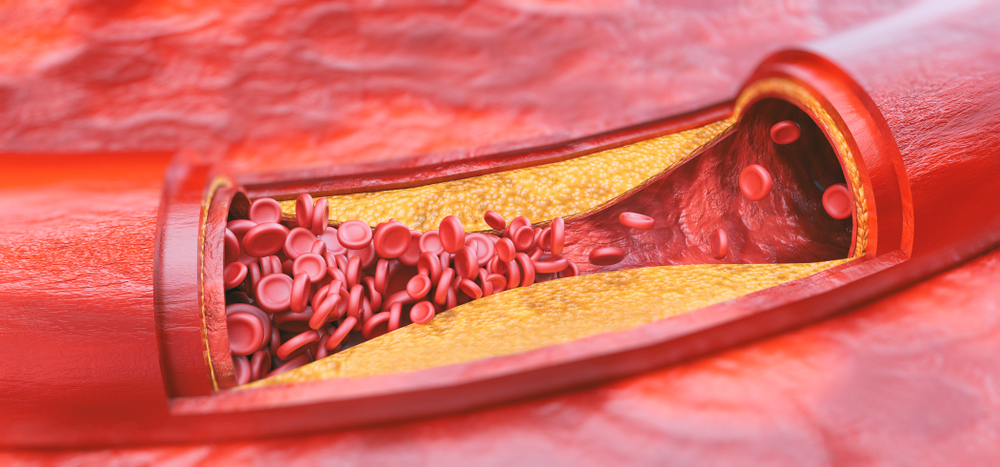
Overview
Atherosclerosis is a disease that happens due to the build-up of plaques on the inside walls of the arteries. The arteries are blood vessels that carry blood and oxygen from the heart to other body parts. Plaques are sticky substances made of fat, sodium, or calcium.
Sometimes they clog the arteries, making them hard and narrow, increasing the blood vessel’s pressure. If this pressure becomes too intense, the plaque can rupture, leading to a life-threatening condition, like a heart attack or stroke.
Atherosclerosis develops over a while and might not show any symptoms until a complication like a heart attack or stroke occurs.
Key facts
- Atherosclerosis is the gradual hardening of the arteries due to the build-up of plaques.
- Plaques in the arteries can cause them to harden, cutting off blood flow.
- They can also burst due to pressure and lead to a blood clot, which in turn triggers a stroke or heart attack.
- Atherosclerosis usually presents no symptoms until it has reached critical stages.
- Some of its warning signs include chest pain (angina), shortness or loss of breath, sweating, nausea, and unexplained loss of muscle strength.
- Atherosclerosis can be treated and prevented by a healthy lifestyle.
Symptoms
Atherosclerosis symptoms are usually particular to the function of the artery or arteries affected.
Mild atherosclerosis usually does not show any symptoms. This condition only begins to present symptoms when the artery has been so clogged by plaques it can no longer supply blood to body organs and tissues.
The blood clot can break apart and cause a heart or stroke in some cases.
Symptoms usually range from moderate to severe depending on the arteries affected. For instance, if the atherosclerosis is in your heart arteries, you may experience chest pain (angina).
Suppose you have atherosclerosis in the arteries leading to your brain. You may experience sudden weakness or numbness in your arms or legs, difficulty speaking or slurred speech, temporary loss of vision in one eye, and drooping muscles in your face. These are signals of transient ischemic attack (TIA), which, if left unattended, may develop into a stroke.
Suppose you have atherosclerosis in the arteries in your arms and legs. In that case, you may have signs or symptoms of peripheral artery disease, such as leg pain when walking (claudication) or decreased blood pressure in an affected limb.
If you have atherosclerosis in the arteries leading to your kidneys, you develop high blood pressure or kidney failure.
Diagnosis
You may have to see a doctor specialising in heart diseases (a cardiologist) for suspected atherosclerosis. Your doctor will perform a physical examination and ask you questions about your symptoms, medical history, and lifestyle choices.
Using a stethoscope, your doctor may also listen for noise (bruit) in your breathing.
Following the physical examinations, your doctor may order one or more of these tests;
- Blood tests: Your healthcare provider may conduct blood tests to check blood sugar and cholesterol levels, as high blood sugar and cholesterol levels increase your risk of atherosclerosis.
- Chest X-ray: A chest X-ray may be conducted to take pictures inside your chest.
- CT scan: It takes pictures inside your body and can show any blockage, narrowing, or hardening of your large arteries.
- Echocardiogram (echo): It takes pictures of your heart’s valves and chambers and measures how well your heart is pumping.
- Electrocardiogram (EKG): This simple and pain-free test records your heart’s electrical activity or signals.
- Ankle/brachial index. This test is used to check if you have atherosclerosis in the arteries of your legs. Your healthcare provider will compare the blood pressure in your ankle to the blood pressure in your arm to measure the blood flow in your limbs. Any difference could be a sign of atherosclerosis.
- Exercise stress test: This is used to measure your heart pressure and how well it functions while exercising.
- Carotid ultrasound: This test takes pictures of the arteries in the body. It detects any narrowing or hardening of the arteries that transport blood to your brain.
- Abdominal ultrasound: This test is used to capture images of your abdominal aorta. It checks for swelling (abdominal aortic aneurysm) or plaque build-up in your aorta.
Causes
Damage to the inner lining of your arteries (endothelium) causes atherosclerosis to start developing. The damage usually progresses over a long period; it may even begin as early as childhood.
Although the exact cause is unknown, the damage may be caused by:
- High cholesterol
- High blood pressure
- High triglycerides, a type of fat (or lipid) in your blood.
- Smoking
- Insulin resistance, obesity, or diabetes
- Inflammation from diseases such as lupus, psoriasis, arthritis, inflammatory bowel disease, or other unknown causes.
Prevention
Atherosclerosis is not entirely preventable. However, you can reduce your risk and lessen the effects of the disease. Some of the measures you can take include;
- Exercise regularly
- Eat a healthy diet. Avoid saturated and trans fats and food high in cholesterol, sodium (salt), and sugar.
- Maintain a healthy weight
- Properly manage health conditions like diabetes, hypertension, and high cholesterol.
- Quit smoking.
- Go for yearly checkups with your primary healthcare provider.
Treatment
Atherosclerosis is not reversible but can be managed, so it does not progress and lead to a heart attack or stroke. Treatment usually involves lifestyle modifications; your healthcare provider will work with you on the best form to take. They are typically targeted at;
- Slowing or stopping plaque build-up in your arteries.
- Lowering your risk of blood clots.
- Helping you make healthier food choices.
- Preventing life-threatening complications like a stroke or heart attack.
- Easing symptoms that cause you pain or discomfort.
- Widening your arteries or bypassing blockages to help your blood flow better.
Your doctor might prescribe medications to control your blood pressure, reduce your blood cholesterol, prevent blood clots, and manage your blood glucose levels.
Some people with atherosclerosis might require surgical procedures, such as:
- Coronary artery bypass surgery.
- Coronary angioplasty.
- Carotid endarterectomy.
Conclusion
Atherosclerosis is a disease that results from plaque build-up in the inside walls of the arteries. Health conditions like diabetes, high cholesterol, and high blood pressure can put you at risk of atherosclerosis. Lifestyle modifications, medications, and surgery can prevent the disease from worsening. Getting an annual checkup is essential to catch and manage any related conditions.
MOST COMMON






